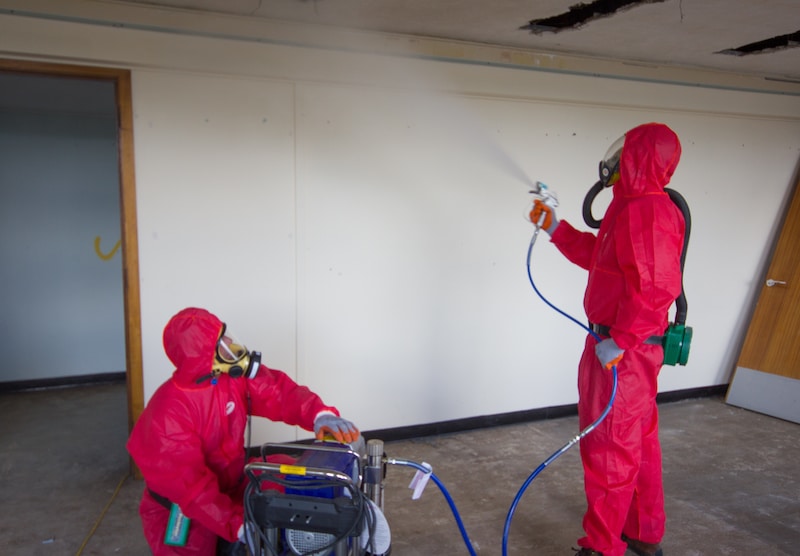Does COSHH cover asbestos?
All sorts of products contain asbestos. It’s present in everything from car brakes and textured paints to machinery and building insulation. However, it poses such a health hazard that between 1985 and 1999, the UK banned the importation of blue, brown, and white asbestos. Those are the three main types of asbestos, with blue and brown being the most dangerous. When breathed in or swallowed, asbestos can lead to various diseases, sometimes only causing problems a decade or more in the future.
In the UK, asbestos is the most prominent cause of work-related deaths. A 2020 health and safety statistics report showed 2,544 mesothelioma deaths caused by asbestos exposure. Additionally, there were approximately 2,500 lung cancer deaths with links to asbestos. Construction workers, electricians, engineers, and plumbers are at exceptionally high risk due to the nature of their jobs.
However, are there any UK regulations for asbestos besides the ban on importation?
It certainly continues to pose a problem. The Trades Union Congress has found the presence of asbestos in blood donor clinics, hospitals, and other buildings in the UK. Ian Lavery, Labour MP, said, “If asbestos is in a building, it will at some point become dangerous if it’s disturbed, so we need plans in place for its removal from all public buildings.”
UK laws aim to protect workers from asbestos but are those regulations part of COSHH, though?
What is COSHH?
Issued in 2002, the Control of Substances Hazardous to Health (COSHH) is a set of regulations governed by the Health and Safety Executive (HSE) in the UK. According to the HSE website, “COSHH is the law that requires employers to control substances that are hazardous to health.”
A leading goal of COSHH is to limit or reduce workers’ exposure to hazardous substances. COSHH does that through several mandates, such as:
- Discovering health hazards of substances
- Providing proper training for employees
- Planning for emergencies
COSHH covers various substances, including biological agents, chemicals, dusts, and fumes. You can see a list of the different substances covered here. COSHH applies in every workplace in the UK, as all businesses have some amount of exposure to at least one type of hazardous substance.
However, COSHH only covers some possible hazardous substances since some, like lead, have their own regulations.
Does COSHH cover asbestos?
In short, COSHH does not cover asbestos, but the regulations do mention asbestos. Regulation 5 of COSHH explicitly states the exclusion of the Control of Asbestos at Work Regulations. It’s critical to manage asbestos, which is why the substance is significant enough to have its own set of laws.
Along with asbestos, COSHH does not cover Coal Mines (Respirable Dust) or Control of Lead at Work regulations. There are separate sets of laws for each hazardous substance.
Why don’t COSHH regulations cover asbestos?
COSHH regulations do not cover asbestos because it’s hazardous enough to require its own set of rules. If asbestos did not have its own laws, COSHH would cover it.
You can read about regulations for managing and working with asbestos here. Additional literature from the HSE about asbestos.
Do you need to carry out a COSHH assessment for asbestos?
Since COSHH excludes asbestos, you don’t need to carry out a COSHH asbestos assessment. However, the evaluation, control, and monitoring of asbestos are still required in the workplace. These regulations just don’t fall under COSHH.
What are the legal asbestos requirements?
Since asbestos is such a high-risk substance, there are strict rules for dealing with asbestos in the workplace. These rules fall under the Control of Asbestos at Work Regulations, which went into effect in April 2012. They updated the previous regulations, though specific guidelines stayed the same. Current regulations cover situations like the following:
- If existing materials containing asbestos are in good condition and are not prone to damage, they can remain as-is. It’s necessary to monitor the materials’ condition to ensure they remain undisturbed.
- In most cases, a licensed contractor must carry out work with asbestos. Additionally, anyone exposed to asbestos at work must undergo mandatory training.
- Should the disturbance of asbestos occur in an uncontrolled way, an incident report is mandatory.
- Workers performing unlicensed work with asbestos must be under health surveillance by a doctor.
There are several other regulations as well. They cover requirements like identifying and managing asbestos, preventing exposure to asbestos, and handling asbestos-related emergencies.
Do asbestos requirements change based on building use?
Yes, the plans for the building (such as regular occupation versus demolition work) factor into the regulations you have to follow.
For example, if there are plans for the demolition or refurbishment of a building that would expose workers to asbestos. A survey to assess the type and condition of the asbestos must occur. It’s necessary to seal or remove any asbestos found. Also, a common requirement is notifying the authorities before work can begin.
However, should the building have normal occupancy. An assessment of the presence of asbestos will take place. From there, though, you may only have to monitor and protect materials with asbestos from disturbance. As long as the asbestos remains protected, no other steps are necessary.
How can I manage asbestos?
To manage asbestos, follow these three integral steps:
1. Determine if there is asbestos present.
If there is asbestos present, find out where it is and its condition. If there aren’t records you can use to find this information, you may need to schedule a sampling and survey. There are different types of surveys:
- Management surveys: These determine if anyone is being harmed by the presence of asbestos during normal occupancy. Sometimes, there is a small amount of disturbance or intrusive work to the building.
- Demolition and refurbishment surveys: These surveys occur before demolition or refurbishment work takes place. These surveys are destructive and intrusive, as the point is to locate any and all materials containing asbestos for removal.
2. Assess how much of a risk is present.
First, consider the condition, location, quantity, and type of asbestos present in the building. Then, determine the exposure level of asbestos to workers.
3. Come up with a plan.
If your building contains asbestos, you’ll need to make a plan to manage the risk, take action and communicate effectively. The plan may include putting out an asbestos policy statement, assigning management duties, and training employees.
What’s the real danger of asbestos?
Diseases related to asbestos can take as long as 40 years to develop. Plus, asbestos can be present in buildings constructed or renovated before 2000. As workers cut into walls or drill into building structures, they could disturb and then inhale asbestos without realizing it.
Asbestos that is in good condition and remains undisturbed does not typically pose a risk. Those who work with or close to materials that contain asbestos, though, may have an exposure level that’s well above a typical environmental level. When repeated, cumulative exposure can cause diseases later in life, including asbestosis, diffuse pleural thickening, lung cancer, and mesothelioma.
Knowing how to prevent asbestos exposure and what to do should it occur is integral to staying in line with UK law.
Contact the team at Oracle Solutions today for information about keeping your workforce safe from asbestos exposure.

Written by Brendan Coleman
Brendan Coleman, with decades of experience in the asbestos industry, is a dedicated Quality Manager. Certified as a surveyor and analyst, he is adept in operations and quality management with a keen focus on HSE compliance. His expertise is pivotal in maintaining high safety and efficiency standards. Brendan ensures our UKAS accreditation requirements are consistently met and exceeded, upholding stringent standards in asbestos remediation. His commitment to enhancing quality and customer satisfaction makes him an essential advisor in asbestos management.

